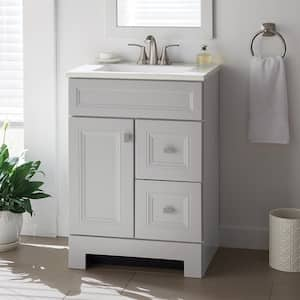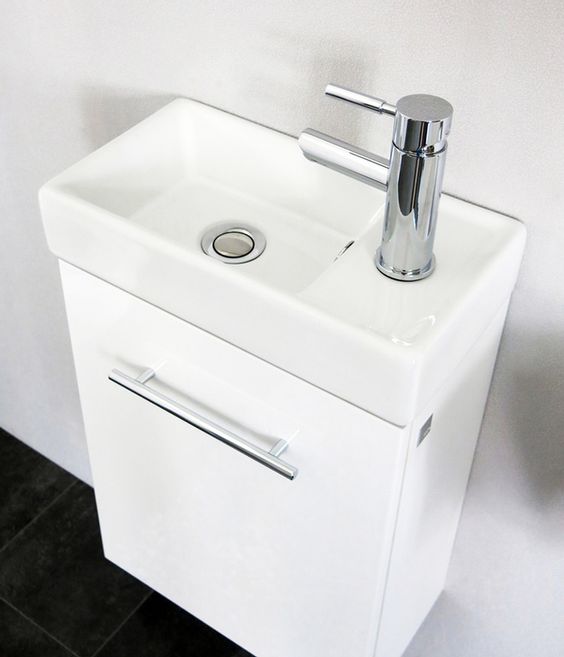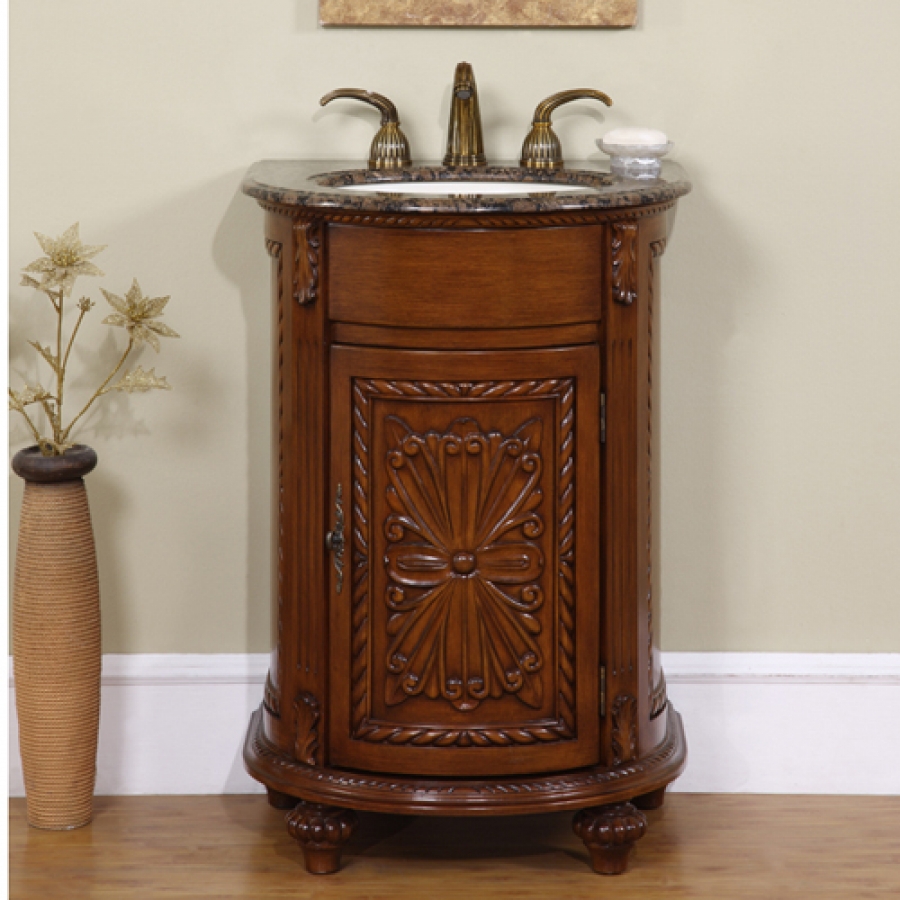Choosing the Right Size: Finding the Perfect Small Bathroom Vanity
Selecting the right size vanity for a small bathroom can be a tricky task, especially when you’re trying to balance practicality with design. A vanity that’s too large can make the space feel cramped, while one that’s too small might lack essential storage or counter space. Here’s how I approach the challenge of finding the perfect small bathroom vanity that suits both the room and my needs.
- Measure Your Space: Before anything else, I always measure the available space, taking into account not only the floor space but also how the vanity will interact with other elements in the room like the toilet or shower. You’ll want to ensure there’s at least 20 inches of clearance around it for comfortable movement.
- Consider Depth: In a small bathroom, vanity depth is critical. I often opt for a vanity that’s between 12-18 inches deep rather than the standard 21 inches. This keeps the room feeling open without sacrificing too much countertop space.
- Focus on Height: A vanity height between 32-34 inches tends to work well for most adults. However, if the vanity is going to be used by children or in a family bathroom, I might opt for something lower to accommodate all users.
- Utilize Corners: When space is tight, corner vanities can be lifesavers. They make use of awkward angles and free up the central part of the room, giving the illusion of more space while still providing storage and function.
- Pay Attention to Style: A slim, sleek vanity with clean lines works best in small spaces. Heavy or bulky pieces tend to overwhelm the room. I like to choose designs with minimal hardware to keep the look light and airy.
- Match the Vanity to the Bathroom’s Shape: I always consider the overall layout of the bathroom. If it’s long and narrow, a rectangular vanity may be better, while for square bathrooms, a rounded or more compact vanity works best.

Maximizing Storage in a Compact Vanity: Clever Space-Saving Solutions
One of the biggest challenges of a small vanity is the limited storage space. However, I’ve learned that with a bit of creativity, you can maximize even the smallest of vanities. By employing clever storage solutions, I’ve found ways to make my compact vanity not only functional but also clutter-free.
Use Drawer Organizers: One of my favorite hacks is to use drawer organizers. Dividers help me store makeup, toothbrushes, and other small items in an orderly manner. This prevents the dreaded junk drawer situation where everything ends up in a tangled mess.
Add Shelves: Inside the vanity doors, I install adjustable shelves to make use of the vertical space. This allows me to store extra towels, cleaning supplies, and toiletries, keeping them accessible but out of sight.
Utilize Baskets and Bins: I’ve found that baskets or bins under the sink are perfect for storing bulky items like extra toilet paper or larger toiletries. They keep everything contained, making the most of the space without creating visual clutter.
Inside the Cabinet Doors: Installing small shelves or adhesive hooks inside the vanity doors is a game-changer for storing hairdryers, towels, or even cleaning supplies. It’s an underused space that provides easy access without taking up counter space.
Pull-Out Organizers: Some vanities come with built-in pull-out drawers or trays. These can make it easier to access items at the back of the vanity, which is especially useful in smaller spaces where reaching deep into a cabinet can be a hassle.
Open Shelving: If my vanity doesn’t have enough closed storage, I like to opt for models with open shelves underneath. This provides extra space for baskets, towels, or decorative items, while still keeping the room feeling open.
Small Vanity Styles: Sleek and Minimal Designs for Tiny Bathrooms
A small bathroom doesn’t mean you have to compromise on style. I’ve found that sleek, minimal vanity designs can make a big impact in a small space. The trick is to focus on simplicity and clean lines to keep the bathroom looking open and uncluttered.
Floating Vanities: One of my favorite styles for small bathrooms is the floating vanity. Mounted on the wall, these vanities free up floor space and create the illusion of a larger room. They’re modern, sleek, and perfect for tiny bathrooms where space is at a premium.
Narrow, Tall Designs: Instead of going wide, I look for narrow vanities that still offer plenty of storage. Tall, slim designs help maintain a small footprint while providing enough counter and cabinet space.
Minimal Hardware: I avoid vanities with large or ornate handles, which can make a small bathroom feel cluttered. Instead, I prefer vanities with built-in pulls or sleek metal hardware for a minimalist look.
Monochromatic Colors: Choosing a vanity in the same color as the walls or tiles helps the piece blend in seamlessly, making the space feel larger. I tend to stick with neutral tones like white, gray, or soft pastels to keep the design cohesive.
Glass or Mirrored Accents: A vanity with glass or mirrored surfaces can help reflect light and make the room feel brighter and more spacious. I find these materials work particularly well in modern, minimalistic bathrooms.
Compact Sinks: I opt for a small, shallow sink to go with the vanity, which saves even more space. Vessel sinks are a great option as they sit on top of the counter, freeing up space inside the vanity for storage.
Material Choices for Small Vanities: Balancing Aesthetics and Durability
When choosing a small vanity, I pay close attention to the materials. The right choice can enhance the aesthetics of the bathroom while ensuring durability. It’s all about finding a balance between style and functionality, especially in a room prone to moisture and wear.
Solid Wood: While it can be more expensive, I love the warmth and durability of a solid wood vanity. It’s resistant to moisture and stands the test of time, especially if it’s properly sealed. Oak, walnut, and teak are great options for a classic, timeless look.
Engineered Wood: For a more affordable option, I often opt for engineered wood. It mimics the look of solid wood but is more resistant to moisture. However, it’s important to ensure it’s a high-quality version that won’t warp over time.
Laminate: Laminate vanities are a budget-friendly option and come in a wide variety of colors and patterns. They’re easy to clean and maintain, but I always make sure to choose a high-quality laminate to prevent peeling or chipping in the humid bathroom environment.
Glass: I’ve experimented with vanities that incorporate glass elements, such as glass countertops or vessel sinks. Glass is sleek and modern, and it reflects light, making the bathroom feel more open. It’s easy to clean but can be prone to showing fingerprints.
Stone: For countertops, I love the look of natural stone like marble or quartz. These materials are luxurious and durable, though they do require some maintenance to prevent stains or watermarks. Quartz, in particular, is more low-maintenance than marble, which can be a good compromise.
Metal Accents: I find that adding metal accents, whether in the form of hardware or frames, gives the vanity a polished look. Brass, chrome, or matte black finishes can elevate the design while being resistant to moisture and wear.
Integrating a Small Vanity with Your Bathroom Decor: Tips for Seamless Design
A small vanity can easily become the focal point of your bathroom, so it must integrate seamlessly with the rest of the space. I always aim for cohesion between the vanity and other bathroom elements to create a harmonious design. Here’s how I ensure my vanity doesn’t look out of place.
Match the Vanity Finish to the Rest of the Room: One way I create cohesion is by matching the vanity finish to other elements in the bathroom, like the mirror frame, towel racks, or faucets. Consistency in finishes, whether it’s wood, metal, or painted surfaces, makes the room feel unified.
Choose a Coordinating Countertop: The countertop material can either blend in or stand out. For small bathrooms, I prefer a countertop that matches the tile or wall color, which helps maintain a seamless look. If I want the vanity to be the star of the room, I’ll go with a contrasting countertop.
Stick to a Color Palette: Keeping a consistent color palette throughout the bathroom ties everything together. I like to use soft neutrals or monochromatic schemes in small bathrooms, as they make the space feel larger and more cohesive. The vanity is an opportunity to introduce a pop of color if done subtly.
Incorporate Matching Fixtures: From faucets to cabinet handles, I like to ensure that all the fixtures match the overall style of the vanity. Whether it’s modern chrome or rustic brass, matching hardware elevates the design and brings the room together.
Use Mirrors to Enhance the Space: I find that placing a large mirror above the vanity helps reflect light and makes the bathroom feel bigger. Frameless mirrors, in particular, create a clean, minimal look that complements a small vanity without adding visual clutter.
Decorative Elements: I try to keep decorative elements simple, opting for minimal accessories like a small potted plant or a sleek soap dispenser that coordinates with the vanity. Less is more when it comes to keeping a small bathroom looking open and airy.
Wall-Mounted vs. Freestanding: Which Vanity Style Works Best in Small Spaces?
Choosing between a wall-mounted and freestanding vanity can have a significant impact on how a small bathroom feels. I’ve used both styles in various spaces and learned that each has its own set of advantages depending on the layout and needs of the bathroom.
Wall-Mounted Vanities for a Modern Look: In smaller bathrooms, I often gravitate toward wall-mounted vanities. Since they don’t touch the floor, they make the space feel larger by exposing more of the floor area. Wall-mounted vanities are also ideal for a modern, minimalist design.
Freestanding Vanities for Storage: If I need more storage, a freestanding vanity can be a better option. These typically offer more cabinet or drawer space, making them ideal for bathrooms that require additional storage. They’re also easier to install and tend to come in a wider variety of styles.
Space Considerations: Wall-mounted vanities work best in very tight spaces where every inch matters. They create the illusion of more floor space, making the bathroom feel larger. However, if the bathroom is slightly bigger, I might opt for a compact freestanding model to maximize storage.
Installation and Plumbing: Wall-mounted vanities often require more complex plumbing and installation since the pipes may need to be concealed within the wall. Freestanding vanities are simpler to install, especially in older homes where the plumbing can’t be easily altered.
Aesthetic Preferences: Wall-mounted vanities give the bathroom a sleek, modern vibe, while freestanding vanities can offer a more traditional or rustic look, depending on the design. I usually choose based on the overall style I’m going for in the bathroom.
Maintenance and Cleaning: One of the benefits I love about wall-mounted vanities is how easy they are to clean around. With the floor exposed, it’s simple to sweep or mop underneath. Freestanding vanities, while offering more storage, can sometimes make cleaning a little more cumbersome.
Budget-Friendly Small Vanities: Affordable Options Without Sacrificing Style
You don’t need to break the bank to find a stylish small vanity. I’ve discovered that there are plenty of affordable options that still look great and function well. By focusing on a few key elements, I’ve been able to find budget-friendly vanities that suit my needs without sacrificing aesthetics.
Look for Engineered Wood: I often opt for engineered wood vanities, which offer the look of real wood without the higher price tag. These vanities are durable and moisture-resistant, making them a smart choice for bathrooms. Plus, they come in a variety of finishes that can match any style.
Go Minimal: Simple, minimal designs tend to cost less than ornate, detailed pieces. I find that minimalist vanities not only save money but also look sleek and modern in small bathrooms. Clean lines and straightforward designs are usually more affordable and easier to maintain.
Laminate Options: Laminate vanities are another budget-friendly option. They come in a wide range of styles, from wood grain finishes to solid colors. Laminate is easy to clean, durable, and much more affordable than natural wood or stone.
DIY Customization: Sometimes I buy a basic, budget-friendly vanity and customize it myself. A fresh coat of paint or swapping out the hardware can make a big difference and personalize the piece to fit my style without the added cost of a designer vanity.
Consider Second-Hand or Upcycled Vanities: Thrift stores, salvage yards, or even online marketplaces are great places to find affordable vanities. I’ve had great success finding vintage pieces that I can refinish or repurpose. Upcycling an older vanity can add character to the bathroom while keeping costs down.
Shop Sales and Discounts: I always keep an eye out for sales, whether it’s during major holidays or from retailers clearing out last season’s designs. Shopping during these times allows me to snag a great deal on a stylish vanity that might normally be out of my budget.
Small Size Bathroom Vanity With Storage
Vanity Buying Guide Bathroom
Space Saving Vanities for Small Bathrooms Unique Vanities
Modern Style Small Size Solid Wood Bathroom Vanity Cabinet
Related Posts:







u0026$SectionHero$)

